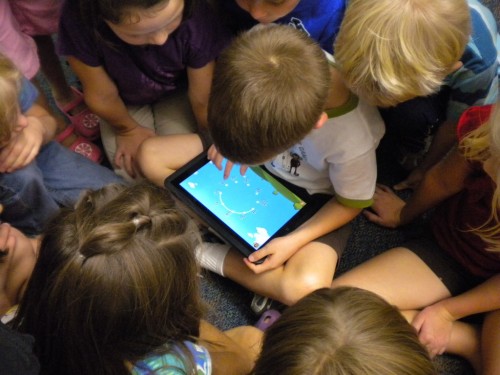As a rule, parents tend to experience concern about their children’s wellbeing. With all of the decisions that parents have to make, I imagine it’s near impossible not to worry that you are making the wrong ones, with consequences that may not reveal themselves for years to come. This is why recommendations from professional organizations are so important. They offer the comfort of a guiding word, based presumably in expertise, to help parents make the best decisions possible.
The American Academy of Pediatrics (AAP) is one such organization, and they have some things to say about children and screen time. However, what they have to say about children and screen time will be revised in the next year, and no doubt, many parents will listen intently. NPR interviewed David Hill, chairman of the AAP Council on Communications and Media and a member of the AAP Children, Adolescents and Media Leadership Working Group. Although Hill did not reveal what the new recommendations would advise, the way he talked about the relationship between screens and kids did reveal a lot about the logic that drives recommendations. The logic that Hill’s interview revealed made clear, once again, the need for theory to inform practice. More specifically, those who make practical recommendations about technology should consult with technology theorists.
The sneaky thing about assumptions is that they inform our way of thinking without letting on that they are doing so. A theorist is trained to identify underlying assumptions and question how they shape proceeding action. From Hill’s interview, three assumptions stand out: screens are a singular category; “screen time” is inherently harmful; and digitally mediated play is distinct from analog forms of play, the latter more “real” than the former.
The most glaring (and easiest to problematize) assumption is that screens occupy a singular category. Recommendations don’t apply differentially to ipads, televisions, or phones, let alone to the immense diversity of media content that each piece of hardware hosts. Of course, condensing screens into a singular category is likely done for reasons of parsimony—busy parents don’t have time to read nuanced recommendations about the full variety of hardware, software, and content available. But that sheer volume of different kinds of screens/ways of using them should perhaps give pause to anyone attempting to give recommendations about them as a categorical unit. Maybe sweeping recommendations aren’t going to be particularly useful.
A second assumption is that screen time is inherently harmful. In the interview, Hill sets up a debate between control over screen time and wholesale screen abstinence, using food and tobacco as the competing metaphors:
The question before us is whether electronic media use in children is more akin to diet or to tobacco use. With diet, harm reduction measures seem to be turning the tide of the obesity epidemic. With tobacco, on the other hand, there really is no safe level of exposure at any age
Although Hill takes the more moderate “food” approach to technology, this still presumes that technology is a dangerous thing to be managed. The assumption of compulsory harm constructs a debate between avoidance and minimization; it depicts technological advancement as an unfortunate juggernaut with which we are forced to contend. Such a depiction robs technology of the opportunity to be good, and eliminates research and recommendations into the complex conditions under which various media are harmful or beneficial, how, and for whom. Further, it constricts the measure of harm and benefit to metrics rooted in analog styles of learning and development. Studying the effects of new media upon old ways of thinking makes little sense, but it does not appear that the AAP is considering the dynamism of the human mind as it adapts to changing cultural realities. A new kind of world requires different kinds of thinking and different kinds of skills. Spelling is less important, information sorting is more important. Intense focus on a single task is needed sometimes, other times it pays to spread attention among multiple and fast-moving targets.
Finally, the AAP seems to operate under the assumption that digital is distinct form physical, and that digital has less substance. In hazarding a preliminary recommendation for parents, Hill advises:
If [children] color or read or play basketball or ride their bikes, take some time to ask them about what they’ve done and why they enjoyed it. These conversations will help them focus on the joys of the “real” world, and they will notice that their activity attracts your attention.
This advice is a clean and clear example of digital dualism, a fallacy we regularly point out and critique on this blog. Concisely, digitally mediated play is equally real to non-digitally mediated forms of play, and both digital and analog play can co-occur.
Hill and the AAP offer an important service. This is why I implore them, and others who help people navigate digitally infused terrains, to talk with people who think about these issues more broadly. A theorist of technology brings a critical eye that can be of use to those with particular empirical expertise, who wish to take action of practical concern. In this case, a technology theorist might offer some solace to parents…your kids are probably going to be okay. Don’t fret. Pay attention to them and pay attention to what they do. Screens aren’t the enemy.
Jenny Davis is on Twitter @Jenny_L_Davis
Headline Pic Source

